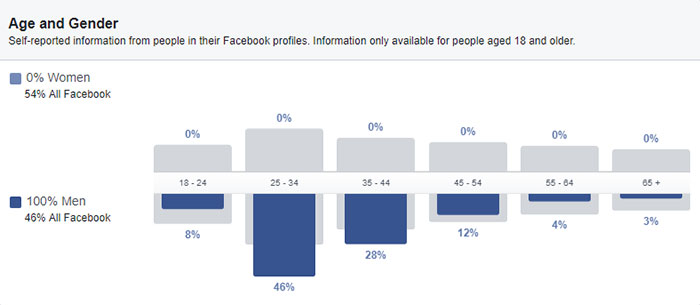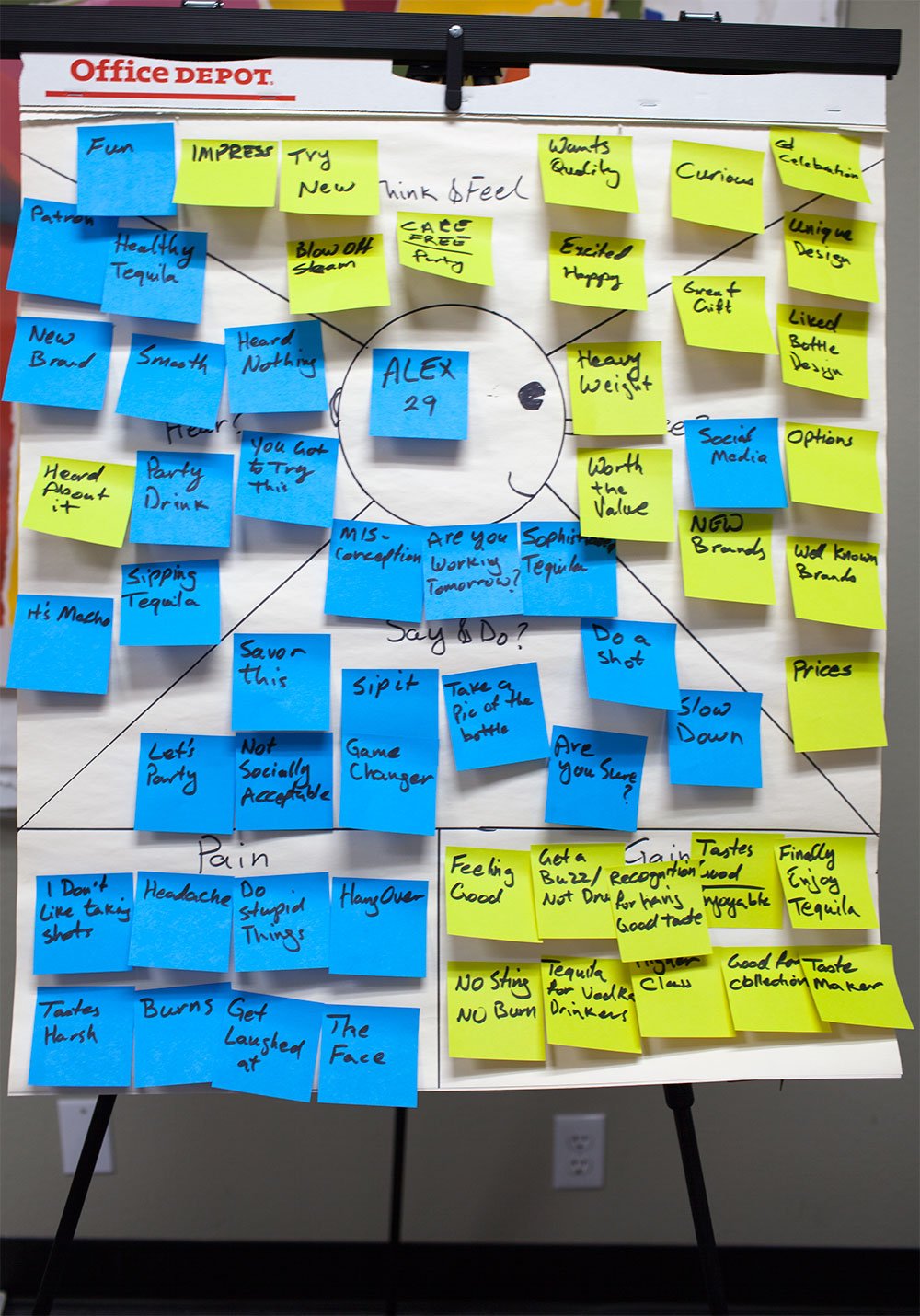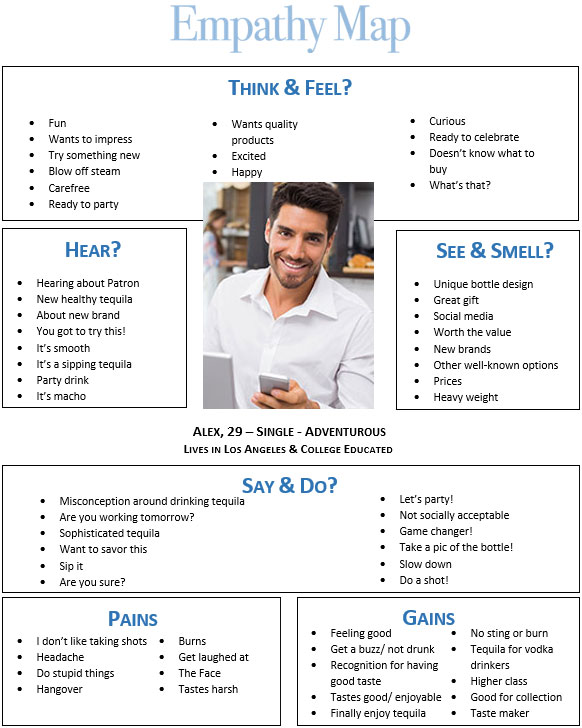
Empathy Mapping
Understanding your Ideal Customer with Empathy Mapping
When it comes to crafting the perfect marketing message, it comes down to one simple thing: Understanding your ideal customer. Everyone knows this, but how exactly do we figure it out? Marketers will achieve this through having empathy mapping sessions to explore every possible angle to look at your ideal customer by. Empathy can literally be defined as “the ability to understand and share the feelings of another,” so as marketers, it is our job to dive in and be masters of empathy.
Getting to the core of who your ideal customer is, what they want and how they want it are the bare bones and building blocks of all marketing strategies. The thing is – it sounds simple, but it can often be a lot more complicated than it seems. Empathy mapping is the first step in crafting design, messaging, delivery channels and really just your overall branding. That’s why it is important to take your time with it and enjoy the process. Generally, it is part of the discovery phase, which is right when you first come on board with a marketing team. The goal with this phase is that we need to not only understand your business better, but your customer as well. It’s one of the parts marketers love most!
As a business owner, you may think that you understand your customer because of how well you understand your business. Whatever it is that your business offers is likely fixing a problem or aiding people in some way, and we want to go after the people who would want to take advantage of it. However, going through an Empathy Mapping Session with a professional marketer could help uncover some things about your business – and your ideal customer – that you may have never known or thought of before. These things could be very important marketing pinpoints that you could have been missing out on.
Creating your ideal customer persona
For the purposes of this blog, imagine a brand new tequila company coming onto the market. Their goal is to get into more stores, more restaurants, more bars and for their message to get across that their tequila is superior in quality to others. They have a specific and special distilling process which results in a smoother taste, and because of this they would like to be considered as a sipping tequila. In result, their particular brand has a higher price point than some other popular tequilas on the market. The bottle is of beautiful design and quality, as is the tequila, which reflects in the pricing.
Taking all of this into account, we would dive into some demographics via Facebook Audience Insights to gather data, and figure out that their ideal customer likely:
- Is between the ages of 25-44
- Has a disposable income
- Has a great paying job
- Is health and trend-conscious
We would literally come up with a name for this person – we will say his name is Alex – as well as a full background for him. What does Alex like to do on the weekend? What does he talk about with his friends? What does Alex struggle with? All of these and more are the exact points that we map out in order to understand Alex better and be able to market to him more effectively.
What does your ideal customer….
When beginning an empathy mapping session, marketers look at these 5 essential questions to answer:
…Think and feel?
Consider Alex just got off of work on a Friday and has stopped into a grocery store on his way home to pick up some items. As a tequila drinker, he walks down the alcohol aisle to casually peruse the different options and figure out what he would like to add to his collection. He stops in front of the tequila area, and we hit the pause button.
Consider Alex gets a call from a friend to come meet up for some drinks one evening. He is handed a drink menu, and he carefully reads over all his options. The waiter asks him what he would like to drink, and we hit the pause button.
Consider Alex just got a huge promotion at work, and his friends and family throw him a small party to celebrate. Alex is relishing in his moment, and decides to stop at the store to grab a nice bottle he can toast with. He stands in front of his options, and we hit the pause button.
What is Alex thinking and feeling at these exact moments?
While these are only 3 scenarios, we come up with absolutely every scenario possible where Alex could interact with this brand. Maybe he’s not even looking to drink tequila at that moment – perhaps he sees an ad in a magazine, he hears a friend talking about it, or he sees someone else walking around with the bottle in their shopping cart. We detail out every one of these scenarios and ask ourselves what Alex could be thinking and feeling at every possible moment.
…Hear?
What does Alex hear about this brand, or about tequila in general? Perhaps a friend at work told Alex about how great it tastes and, as a fellow tequila lover, he decided Alex should know about it. Maybe Alex doesn’t even like tequila at all, but because of the company’s superior quality and taste, people who have tried it would encourage Alex to try it anyway knowing that he might like this one. Or maybe Alex hasn’t even heard anything at all about this brand but wanted to try something new and has the disposable income to spend on it.
Tequila, in general, is shifting in perspective these days, and since Alex follows the latest trends he wants to stay on board and try it out. Historically, tequila has been seen as a notorious party and group drink. Usually paired with headaches the next day, people don’t view it as something that can be “classy”. For example, when someone gets off of a long day of work on a Tuesday and has a glass of wine or whiskey to wind down, it is socially acceptable. If you hear of someone getting off a long day of work and having a glass of tequila on a Tuesday, you might raise an eyebrow. However, since now that the perspective of tequila is shifting from something you simply use as a shot to jumpstart the night into something that has flavor you can sip on, he might want to give it a go. These could all be some things that Alex could be hearing that we can detail out as marketers.
…Say?
When Alex interacts with this brand, what might he say? Consider the scenarios where he is at a bar or a restaurant with a waiter about to take his order. He could be asking what is new that he can try, since he enjoys branching out and isn’t stuck in his ordering ways like a lot of people tend to be when it comes to alcohol. In addition, Alex may be asking his friends, Google or a store employee this same question.
Something else to consider is that Alex could also be saying that he hates tequila. A lot of people have a certain “poison” that they have picked and are set on, and tequila is not on a lot of people’s lists. This can be because of it’s notorious party nature, it’s taste, or its after effects the next day. He could be saying “no” to tequila, but once he hears that this one is different through well-crafted marketing messages, he could reconsider. That is because Alex is our ideal customer in our target market, so even though he doesn’t like tequila, making sure he is aware of what the brand offers could trigger a new customer that this brand might have never had before.
Alex could also be saying all the classic things we all say if we drink alcohol. These could be such phrases as: I need to wind down, I had a long day and need a drink, I want to have a good time or I want to celebrate – all of which need to be worked into the brand’s marketing message as well.
…Do?
Obviously, one of the things that Alex does is drink alcohol. Therefore, he is absolutely in our target demographic and we should go after him. This is where the thought train tends to stop for business owners, but of course, we love to dive much deeper into it.
Does Alex compare products? Does he subscribe to newsletters that tell him what’s the latest or what’s on sale at different shops, such as Bevmo? Does he ask his friends or bartenders for recommendations? Thinking of every possible thing Alex might do which would allow him to interact with this brand are all different marketing opportunities to go after.
If Alex is on social media a lot and follows brands he likes, then it would be beneficial for this brand to have a strong social media presence. If he subscribes to the Bevmo email newsletter, then it would be beneficial to also have their own email marketing, or do what they can to be part of similar newsletters.
Alex might go out often to enjoy the Los Angeles nightlife on the weekends with his friends, so working to get into these popular spots and advertise would be another thing the brand should focus on as well. If Alex works in Beverly Hills, then we could drill down even further and target bars, hotels and restaurants in that area that him and his coworkers would be likely to visit after a long day at the office.
…Gain? Pain?
It is important to think about what Alex would gain once he were to purchase this product. Obviously, Alex would enjoy a nice buzz, which is the main objective for anyone who chooses to drink alcohol. But, what else would he gain? Much like all the other questions above, we need to think outside of the box and dive into every possible scenario.
Let’s say Alex had some friends over at his place and offers a drink to his friends. He takes out some glasses, puts ice in them, pours in this particular tequila and everyone has a sip. Everyone loves it. Now, Alex is seen as the authority on trendy new things to try, and he gains a sense of pride knowing he exposed his friends to this new, great thing.
Or maybe Alex doesn’t like tequila at all, and has essentially written it off because of a few bad experiences. Everyone has certain alcohols that they do and do not like, but people can feel like they are missing out if they wish they like it. Even though he does not like tequila but does like to follow new trends, he decides to take a chance and try this brand thanks to it’s marketing messages. He tastes it, and finds that he actually likes it. Now, Alex has gained a sense of joy that he has a brand of tequila he can finally enjoy with others.
Craft your marketing
Now that we have detailed out every possible scenario that Alex would experience when coming into contact with this brand of tequila, it is time to gather all this research and craft the marketing message. It’s important to not only address the positive experiences but the negative ones as well so that we can know where weaknesses are.
By being able to map out exactly what your customers are feeling, thinking, saying, hearing and doing, you will be able to better understand their pains and gains. You’ll know now what to say, how to say it, where to say it and how to make him feel when you say it.
Let us know!
Have you ever considered these things about your ideal customer? If you are interested in starting your own empathy mapping session to identify your target audience and craft your marketing, give us a call.








